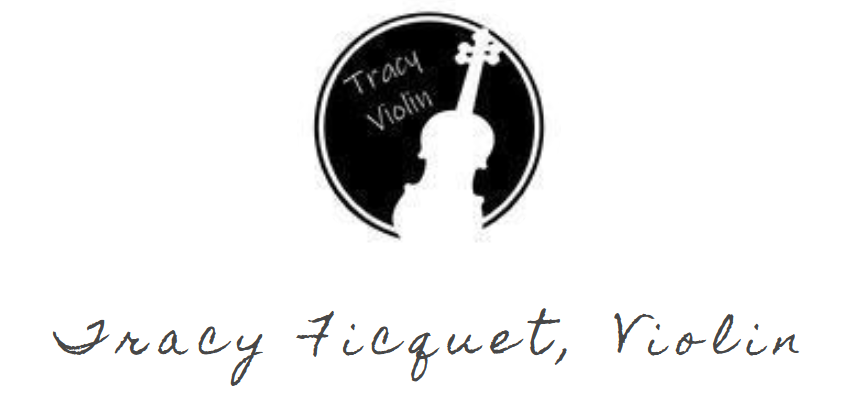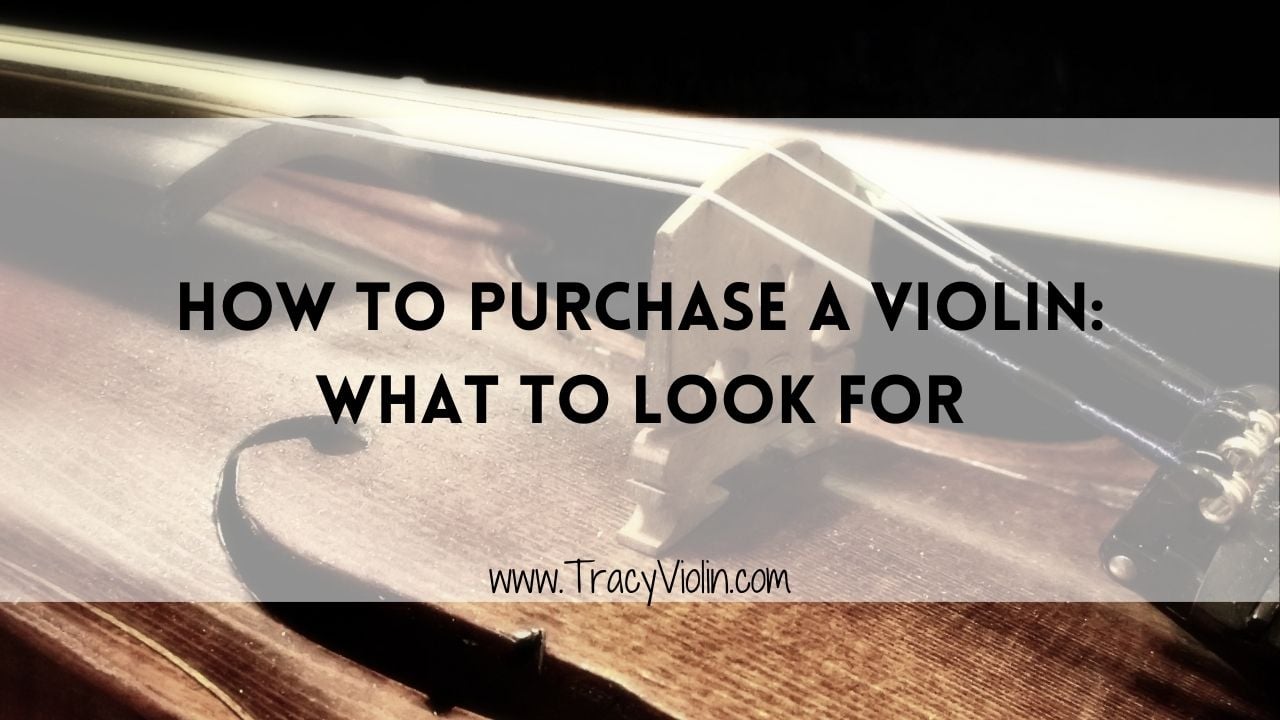What should you look for when purchasing a violin, and how do you go about finding a good deal? This is a question that I get asked often by students and parents. The answer will depend on whether you are a beginner, intermediate, advanced, or professional musician.
1. Purchasing a Beginner Violin
For most beginners, the most important thing is to make sure that your violin is playable. Aside from making sure that your violin is the correct size, look for a well-built, sturdy instrument that is made out of solid wood, preferably maple or spruce. Check the seams between the pieces of wood for a good connection. Also check the 4 strings to see that they are evenly spaced; they should not be too close to each other as to hinder your ability to use your finger to press one string at a time. The 4 strings should also not touch the fingerboard (the long, black ebony plate that is glued onto the neck of the instrument).
Do not buy an instrument that has any wood chips or splinters coming out of it, and especially do not buy a violin that is made out of plywood. You can check if an instrument is made out of plywood by looking at the scroll end of the instrument and looking at the 4 holes where the pegs are inserted. If you see any signs of wear and tear in these holes, chances are that the instrument is made out of plywood, and these holes will lose its shape over time. This will make it difficult for the peg to sit in the correct spot and hold tension in the strings; the result is that the instrument will have difficulty playing a tune.
Beginners should expect to pay at least $150-200 for a violin, or $200-300 if buying a violin outfit. (The term "outfit" means that accessories are also included, such as the bow, shoulder rest, rosin, case, and perhaps some extra strings.) If you choose to buy your violin from a reputable local shop, the sales representative can help you choose the correct size of instrument and guide you through a selection of instruments that have already passed through their minimum guidelines for quality, but you should also expect some markup in price in exchange for this service. It is also possible to find a good deal on local classified ads or even online, but you need to know what you are looking for.
2. Purchasing an Intermediate Violin
You know you are ready for an intermediate violin when you are not satisfied with your beginner violin. A beginner violin is usually not very loud and cannot project its sound across a large concert hall. The sound of a beginner violin might also be described as fuzzy, unclear, or having extraneous noises. A good indicator of needing an intermediate violin is if you are going to learn how to shift your left hand to other positions beyond first position.
An intermediate violin costs about $800-1000 for the violin alone, but expect a markup in price if you are buying the violin at a shop with large physical facilities. A violin that is made in China and assembled locally is increasingly the norm for this price range.
The wood should be solid maple or spruce that has been aged for at least 3 years, as the aging process stabilizes the wood and makes it less prone to damage caused by changes in weather and especially humidity.
One thing to consider when buying an intermediate violin is the quality of the "setup," which refers to the parts of the violin other than the wooden box itself (i.e. the strings, chin rest, bridge, tailpiece, etc.). Some beginner violins are not set up optimally for shifting, especially when the bridge is a mass-produced one. Ideally the bridge should be custom-fit to the violin and have no gaps between the feet of the bridge and the body of the instrument. When considering an intermediate violin for purchase, look at the way that the strings sit above the fingerboard. If the gap between the strings and the fingerboard is too wide, it will be difficult to press the violin strings down when your left hand is in a high position.
The color of the violin does not matter. I once had a salesperson try to sell me a violin that had "superior" varnish which made the sound project further. I smiled politely but laughed inside at such a claim; the type and color of wood varnish is a matter of personal preference.
Once you find a violin that has the qualities you are looking for, always give the violin a play test. If you do not know how to shift your hand into different positions, you can still glide your finger across the entire string, for all 4 strings, to make sure the violin strings are easy to press and that the violin can make a good sound throughout the entire string. Check to see that the sound quality remains pleasant to the ear across the entire range of the violin.
3. Purchasing an Advanced Violin
An advanced, or "fine" violin is necessary for anyone who intends to make music a career or a serious hobby. Anyone wanting to study music at the collegiate level should expect to spend at least $3,000-6,000 for a fine violin that comes directly from a violin maker. Spend any less than that and your sound most likely will not suffice to get you through most university auditions.
With the advancement of the internet, a lot of violin makers are getting better at making their names known, but it is still very difficult to find them as the majority of them do not spend a lot of time doing business or marketing strategies. One trick is to find a list of alumni from a notable violin making school.
If you don't have access to a good violin maker, you can get a violin from a middleman who buys, sells, and trades violins. Typically, these middlemen travel the world to buy violins at a low price and resell them for a higher price at a shop that sells fine violins. However, you should expect some significant markup if you are buying from a middleman, as you are also paying the price for all of these overhead expenses. Look at violins at the $6,000-$12,000 range and be prepared to haggle.
The quality of wood used is probably the single most important factor to look at when purchasing a violin.
A strong tree that has steadily endured harsh, cold conditions is best. You can tell if the wood is of good quality by looking at the lines that run across the wood. Look for thin and evenly spaced lines that indicate slow and even growth in the tree. Also check that the violin's front and back are made of a single piece of wood each rather than 2 planks of wood glued together.
When testing out a violin in this price range, bring the violin to a large concert hall and test how well the sound travels. A violin that is able to project sound to long distances without the use of any external microphone is best. Also check the entire range of the instrument in all 4 strings for sound quality and responsiveness.
4. Purchasing a Professional Violin
If you are planning to be a professional violinist who makes money through music, you will first need to define what kind of career path you want to take. In most cases, an advanced violin as described above will be more than adequate to start making money with your violin.
However, if your goal is to be a professional orchestral player or soloist, or if you want to increase your chances of obtaining admission in a world-class music school, then you will need to have a very expensive fine violin. Some orchestras require in their job postings that you own a violin worth at least $15,000 before they will even consider listening to you, and it is not uncommon for orchestral musicians to own instruments worth much, much more than the required minimum.
In the highest social circles of western classical music, it's an unspoken rule that your violin should come from a historical place of musical significance in Europe. Preferably, your violin should come from an established violin maker located in the city of Cremona, Italy, which is the hometown of Antonio Stradivarius; bonus points if your instrument has historical significance or was previously owned by a famous violinist so that you can brag about your instrument's lineage in your biography. If the violin maker is no longer alive and therefore unable to make new violins, this will also add monetary value to your instrument as well. With all of this said, it is not uncommon for a professional classical violinist to own an instrument worth at least $20,000 up to half a million dollars. Some violins are even worth multiple millions of dollars! If all of this seems a bit elitist, well, it kind of is-- after all, classical music was originally invented through the commission of kings and other members of the wealthy European class.
Summary
There are many factors that go into the price of a violin. Some of these factors are easily calculated, such as the quality of build, craftsmanship, and materials. Other factors that may not be as readily apparent include the perceived reputation of the violin maker, whether the violin maker is still living or not, historical significance, and musical lineage. Finally, business overhead expenses also factor into the final price of the product to the consumer. Understanding these factors can help you determine how to best go about in purchasing a violin.




Comments ()